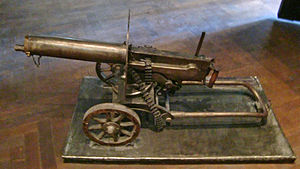Maxim gun
The Maxim gun was a weapon invented by American-British inventor Hiram Stevens Maxim in 1883: it was the first recoil-operated machine gun. It has been called "the weapon most associated with the British imperial conquest".
The mechanism of the Maxim gun employed one of the earliest recoil-operated firing systems in history. The idea is that the energy from recoil acting on the breech block is used to eject each spent cartridge and insert the next one, instead of a hand-operated mechanism. Maxim's earliest designs used a 360-degree rotating cam to reverse the movement of the block, but this was later simplified to a toggle lock. This made it vastly more efficient and less labor-intensive than previous rapid-firing guns, such as the Mitrailleuse, Gatling, Gardner, or Nordenfelt, that relied on actual mechanical cranking. It also decreased the gas buildup in the barrel, allowing the gun to fire more bullets over an extended period of time without overheating the barrel. The Maxim gun design required water cooling, giving it the ability to maintain its rate of fire for far longer than air-cooled guns. The disadvantage of this was that it made the gun less flexible in attack than the lighter air-cooled weapons.
Trials demonstrated that the Maxim could fire 600 rounds per minute. Compared to modern machine guns, the Maxim was heavy, bulky, and awkward. A lone soldier could fire the weapon, but it was usually operated by a team of men. Apart from the gunner, other crew were needed to speed reload, spot targets, and carry and ready ammunition and water. Several men were needed to move or mount the heavy weapon.
Maxim established the Maxim Gun Company with financing from Albert Vickers, son of steel entrepreneur Edward Vickers. A blue plaque on the Factory where Maxim invented and produced the gun is to be found in Hatton Garden at the junction with Clerkenwell Road in London.
Albert Vickers became the company's chairman, and it later joined hands with a Swedish competitor, Nordenfelt, to become Maxim Nordenfelt Guns and Ammunition Company. The Post Office Directory of trades in London of 1895 lists its office at 32 Victoria Street SW (London) on page 1579.
...
Wikipedia

